mobiledet_cpu目标检测
别看了,这玩意没有开源search code部分(没有架构搜索 只是个普通网络)
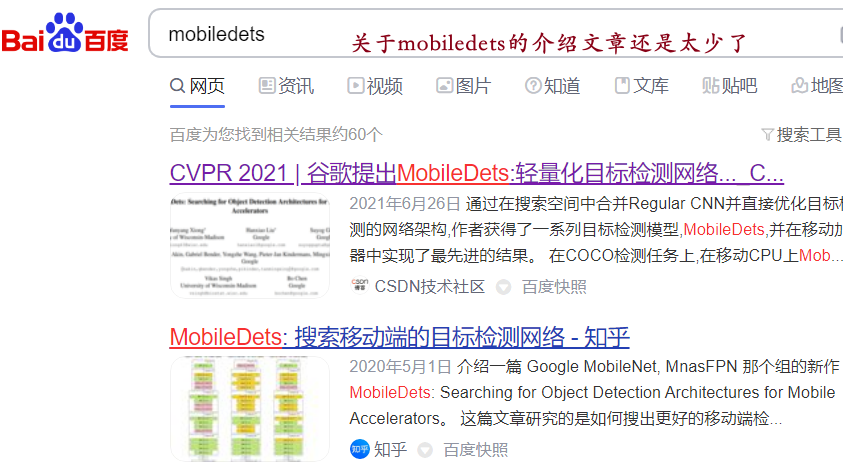 ,
, 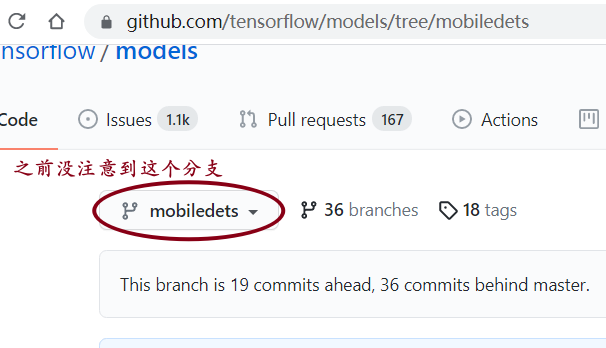
mobiledets原始论文,代码下载,训练模型下载:在object_detection\g3doc\tf1_detection_zoo.md找到ssd_mobiledet_cpu_coco。
在这个md文件中还能看到运行环境说明:

文件结构:
research
-object_detection
-coco_models
-ssdlite_mobiledet_cpu_320x320_coco_2020_05_19 #模型下载位置
-my_ssdlite_mobiledets
-image
-train #训练图片文件夹
-train_xml
-train_labels.csv
-train.record
-test
-test_xml
-test_labels.csv
-test.record
-mycoco.pytxt
-ssdlite_mobiledet_cpu_320x320_coco_sync_4x4.config
-generate_tfrecord.py
一、数据集制作(由image 经过xml和csv 得到.record和pbtxt文件)

①下载一些图片到image/train和image/test中,重命名1-100.jpg

import os # https://blog.csdn.net/qxqsunshine/article/details/80140037 dir_name = r'C:\myprogram\compile\windows_v1.8.1\image\train' files = os.listdir(dir_name) for name in files: print(name) img_len = len(files) for i in range(img_len): oldfn = os.path.join(dir_name, files[i]) newfn = os.path.join(dir_name, str(i) + '.jpg') os.rename(oldfn, newfn)
②使用LabelImg对图片标注 自定义了5个标签[leg,girl,cartoon,plane,cat],生成很多xml文件 放在train_xml和test_xml文件夹中。现把众多xml转换为一个csv文件:
import os import glob import pandas as pd import xml.etree.ElementTree as ET def xml_to_csv(path): xml_list = [] for xml_file in glob.glob(path + '\\*.xml'): print(xml_file) tree = ET.parse(xml_file) root = tree.getroot() for member in root.findall('object'): value = (root.find('filename').text, int(root.find('size')[0].text), int(root.find('size')[1].text), member[0].text, int(member[4][0].text), int(member[4][1].text), int(member[4][2].text), int(member[4][3].text) ) xml_list.append(value) column_name = ['filename', 'width', 'height', 'class', 'xmin', 'ymin', 'xmax', 'ymax'] xml_df = pd.DataFrame(xml_list, columns=column_name) return xml_df def main(): print(os.getcwd()) base_dir = r'C:\myprogram\compile\windows_v1.8.1\image' for folder in ['train_xml', 'test_xml']: image_path = os.path.join( base_dir, folder) # 这里就是需要访问的.xml的存放地址目录 xml_df = xml_to_csv(image_path) # object_detection/images/train or test xml_df.to_csv((base_dir + folder + '_labels.csv'), index=None) print('Successfully converted xml to csv.') main()
现在我把image文件夹由windows_v1.8.1烤到research中
③再一次转换 把图片和标注合在一起:image+labels.csv -->.record

from __future__ import division from __future__ import print_function from __future__ import absolute_import import os import io import pandas as pd import tensorflow.compat.v1 as tf tf.disable_v2_behavior() from PIL import Image from object_detection.utils import dataset_util from collections import namedtuple, OrderedDict flags = tf.app.flags flags.DEFINE_string('csv_input', '', 'Path to the CSV input') flags.DEFINE_string('image_dir', '', 'Path to the image directory') flags.DEFINE_string('output_path', '', 'Path to output TFRecord') FLAGS = flags.FLAGS def class_text_to_int(row_label): if row_label == 'cat': # 这里需要自己修改,有多少个类就该多少个!!!! return 1 elif row_label == 'girl': return 2 elif row_label == 'plane': return 3 elif row_label == 'cartoon': return 4 elif row_label == 'leg': return 5 else: return 0 def split(df, group): data = namedtuple('data', ['filename', 'object']) gb = df.groupby(group) return [data(filename, gb.get_group(x)) for filename, x in zip(gb.groups.keys(), gb.groups)] def create_tf_example(group, path): with tf.gfile.GFile(os.path.join(path, '{}'.format(group.filename)), 'rb') as fid: encoded_jpg = fid.read() encoded_jpg_io = io.BytesIO(encoded_jpg) image = Image.open(encoded_jpg_io) width, height = image.size filename = group.filename.encode('utf8') image_format = b'jpg' xmins = [] xmaxs = [] ymins = [] ymaxs = [] classes_text = [] classes = [] for index, row in group.object.iterrows(): xmins.append(row['xmin'] / width) xmaxs.append(row['xmax'] / width) ymins.append(row['ymin'] / height) ymaxs.append(row['ymax'] / height) classes_text.append(row['class'].encode('utf8')) classes.append(class_text_to_int(row['class'])) tf_example = tf.train.Example(features=tf.train.Features(feature={ 'image/height': dataset_util.int64_feature(height), 'image/width': dataset_util.int64_feature(width), 'image/filename': dataset_util.bytes_feature(filename), 'image/source_id': dataset_util.bytes_feature(filename), 'image/encoded': dataset_util.bytes_feature(encoded_jpg), 'image/format': dataset_util.bytes_feature(image_format), 'image/object/bbox/xmin': dataset_util.float_list_feature(xmins), 'image/object/bbox/xmax': dataset_util.float_list_feature(xmaxs), 'image/object/bbox/ymin': dataset_util.float_list_feature(ymins), 'image/object/bbox/ymax': dataset_util.float_list_feature(ymaxs), 'image/object/class/text': dataset_util.bytes_list_feature(classes_text), 'image/object/class/label': dataset_util.int64_list_feature(classes), })) return tf_example def main(_): writer = tf.python_io.TFRecordWriter(FLAGS.output_path) path = os.path.join(os.getcwd(), FLAGS.image_dir) print(path) examples = pd.read_csv(FLAGS.csv_input) grouped = split(examples, 'filename') for group in grouped: tf_example = create_tf_example(group, path) writer.write(tf_example.SerializeToString()) writer.close() output_path = os.path.join(os.getcwd(), FLAGS.output_path) print('Successfully created the TFRecords: {}'.format(output_path)) if __name__ == '__main__': tf.app.run()
注意修改部分
def class_text_to_int(row_label): if row_label == 'cat': # 这里需要自己修改,有多少个类就该多少个!!!! return 1 elif row_label == 'girl': return 2 elif row_label == 'plane': return 3 elif row_label == 'cartoon': return 4 elif row_label == 'leg': return 5 else: return 0
在research下分别为train和test执行
1 python generate_tfrecord.py --csv_input=image/train_labels.csv --image_dir=image/train --output_path=image/train.record 2 python generate_tfrecord.py --csv_input=image/test_labels.csv --image_dir=image/test --output_path=image/test.record
④取出总标签文件并修改 copy object_detection\data\mscoco_label_map.pbtxt image\mycoco.pbtxt
item {
id: 1
name: 'cat'
}
仿照格式,有多少个类就追加多少个item。coco数据集有80个类别,我这儿只有5个。注意:id必须与generate_tfrecord.py中的id一致
二、修改训练文件
运行环境
(1)修改.config后执行
copy object_detection\samples\configs\ssdlite_mobiledet_cpu_320x320_coco_sync_4x4.config image\
修改image下的.config文件(注意修改位置): 有两个label_map_path ,分别在train_input_reader 和eval_config标签中
num_classes: 5 #原90 batch_size: 16 #原24 批次大小 otal_steps: 40000 #原400000 训练次数 warmup_steps: 200 #原2000 max_number_of_boxes: 20 #原100 sync_replicas: false #原true label_map_path: "C:\\myprogram\\tensor\\models-master\\research\\image\\mycoco.pbtxt" input_path: "C:\\myprogram\\tensor\\models-master\\research\\image\\train.record"
label_map_path: "C:\\myprogram\\tensor\\models-mobiledets\\research\\image\\mycoco.pbtxt"
input_path: "C:\\myprogram\\tensor\\models-mobiledets\\research\\image\\test.record"
fine_tune_checkpoint: "C:\\myprogram\\tensor\\models-mobiledets\\research\\coco_models\\ssdlite_mobiledet_cpu_320x320_coco_2020_05_19\\model.ckpt" from_detection_checkpoint: true #可以修改的地方:是否进行finetune fine_tune_checkpoint_type: "detection"
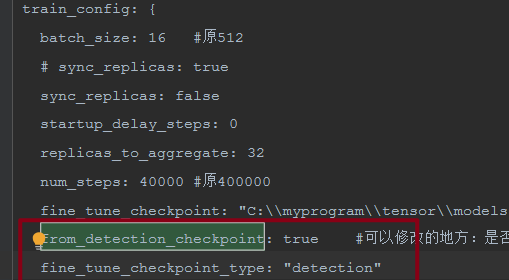

把下载模型文件名中的ssdlite_mobiledet_cpu_320x320_coco_2020_05_19\model.ckpt-400000改为model.ckpt,三个都要改。
最后训练执行:--model_dir 是模型文件暂时存放的目录(随意设定)
object_detection>python model_main.py \
--logtostderr \
--model_dir=../image/ \
--pipeline_config_path=../image/ssdlite_mobiledet_cpu_320x320_coco_sync_4x4.config
(2)解决报错
①【ModuleNotFoundError: No module named ‘object_detection’】很多文件都有from object_detection import…… 不可能把所有文件都弄到research文件夹下。
我一定是漏了什么配置,两种解决办法:
第一方案:
将models\research\object_detection\packages\tf1文件夹下的setup.py复制到models\research目录下,然后执行:
python setup.py build
python setup.py install
下载好多东西 等了十几分钟!
第二方案:
python安装目录下的lib\site-packages文件夹下建立一个tensorflow_model.pth文件,文件内容:
D:\TensoFlowObjectDetectionAPI\models-master\research
D:\TensoFlowObjectDetectionAPI\models-master\research\slim
②【site-packages\tensorflow_core\python\framework\ops.py:736 __array__
" array.".format(self.name))
NotImplementedError: Cannot convert a symbolic Tensor (cond_2/strided_slice:0) to a numpy array.】
解决: numpy版本过高,卸载后重新安装低版本pip install numpy=1.19.5 解决完后就正常执行了!
(3)打开tensorboard
research>tensorboard --logdir=image #打开http://localhost:6006/
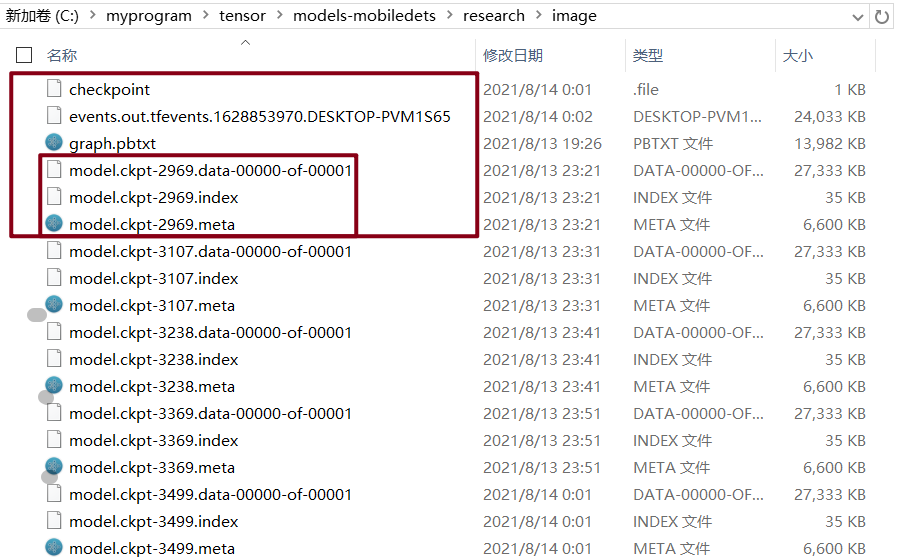
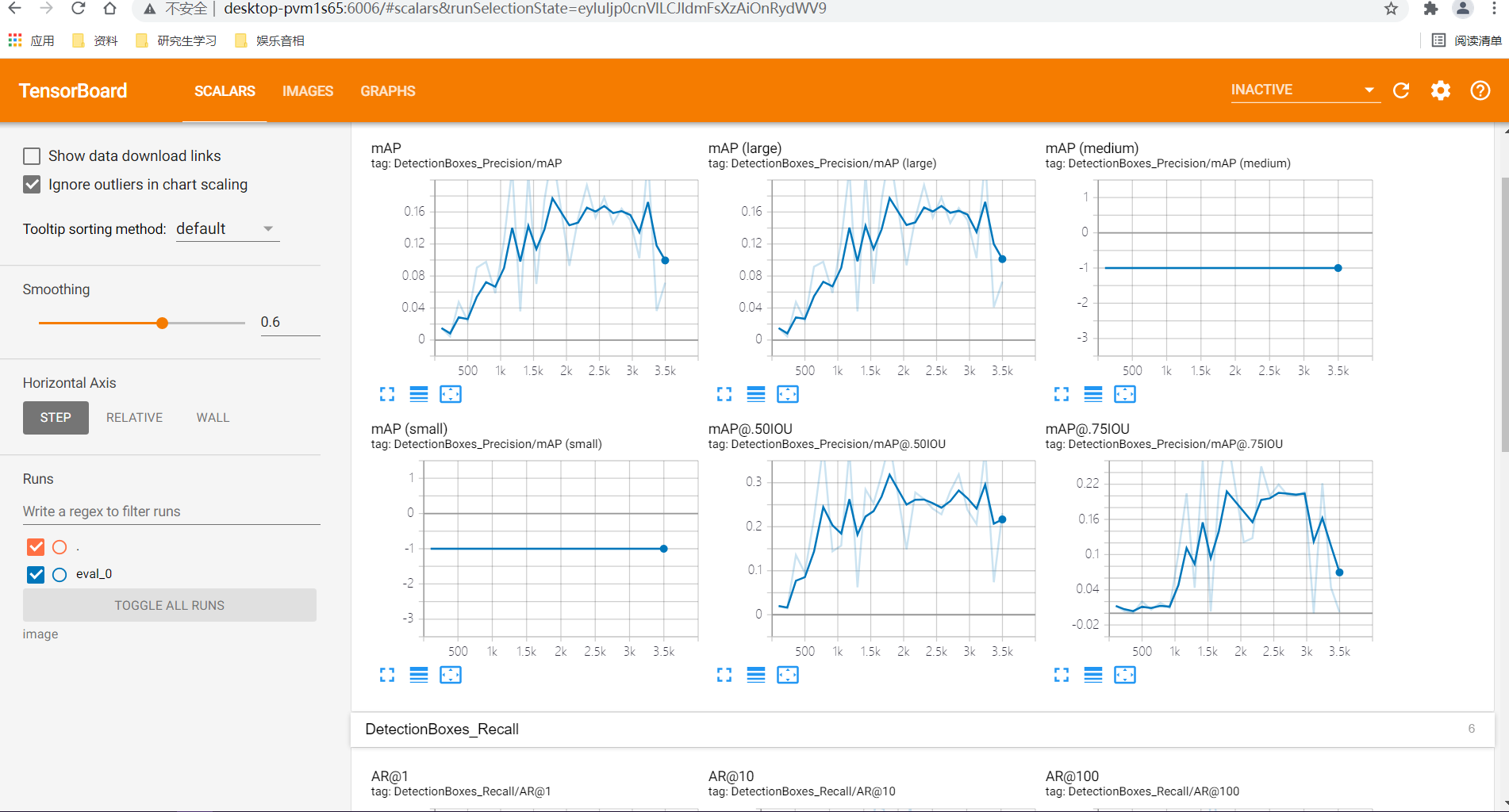
三、模型保存、测试
1)执行: output_directory是生成模型保存的位置(随意设定),本来设定运行4000setp的,还没训练结束就可以保存了。
object_detection>python export_inference_graph.py \ --input_type image_tensor \ --pipeline_config_path ..\image\ssdlite_mobiledet_cpu_320x320_coco_sync_4x4.config \ --trained_checkpoint_prefix ..\image\model.ckpt-3369 \ --output_directory ..\coco_models\my_ssdlite_mobiledets
2)tf1上测试:--checkpoint_dir的目录引用自训练时生成的checkpoint文件所在目录,也可以写保存了的..\coco_models\my_ssdlite_mobiledets;
--eval_dir是生成文件所在目录(随意设定)
research\object_detection> copy legacy\eval.py .\
python eval.py \ --logtostderr \ --pipeline_config_path=..\image\ssdlite_mobiledet_cpu_320x320_coco_sync_4x4.config \ --checkpoint_dir=..\image\ \ --eval_dir=..\image\test\
2.1)tf2上用测试文件,测试可以参见上一篇,就是把下载的模型改为我这里训练好的模型。
该测试文件放在research下,修改文件中三处,然后直接运行即可!注意:运行改在tf2环境下,因为tf1中的tf.saved_model.load函数不太好用,你可以看看。
# -- coding: utf-8 -- import tensorflow as tf import numpy as np from PIL import Image from object_detection.utils import visualization_utils as vis_util from object_detection.utils import label_map_util from PIL import Image import os def test(file, model, category_index): image_np = np.array(Image.open(file)) input_tensor = tf.convert_to_tensor(image_np) # 数据类型np转tensor input_tensor = input_tensor[tf.newaxis, ...] # 因为只有一张图片 三维转四维 output_dict = model.signatures['serving_default'](input_tensor) num_detections = int(output_dict.pop('num_detections')) output_dict = {key: value[0, :num_detections].numpy() for key, value in output_dict.items()} output_dict['num_detections'] = num_detections output_dict['detection_classes'] = output_dict['detection_classes'].astype(np.int64) vis_util.visualize_boxes_and_labels_on_image_array( image_np, output_dict['detection_boxes'], output_dict['detection_classes'], output_dict['detection_scores'], category_index, instance_masks=output_dict.get('detection_masks_reframed', None), use_normalized_coordinates=True, line_thickness=8) Image.fromarray(image_np).show() if __name__ == '__main__': model_dir = r"C:\myprogram\tensor\models-mobiledets\research\coco_models\my_ssdlite_mobiledets\saved_model" mypbtxt = os.path.join(r"C:\myprogram\tensor\models-mobiledets\research\image", "mycoco.pbtxt") model = tf.saved_model.load(model_dir) category_index = label_map_util.create_category_index_from_labelmap(mypbtxt, use_display_name=True) img_test_dir = r'C:\myprogram\tensor\models-mobiledets\research\image\test' for file in os.listdir(img_test_dir): print(file) test(os.path.join(img_test_dir, file), model, category_index)
电脑比较拉了 样本也太少,训练五个小时的效果好差哦;训练集上还好 !
 ,
,
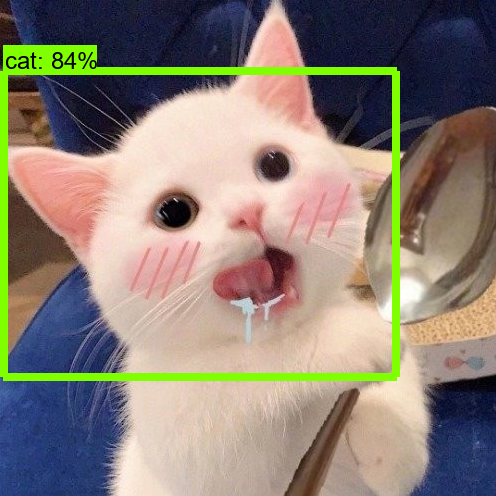 ,
,
参考博客:
https://blog.csdn.net/qq_17854471/article/details/89786400 tensorflow使用object detection完成目标检测的实例——无数的坑超详细吐血整理
https://blog.csdn.net/qq_35975447/article/details/108295070 tensorflow/models-v1.12.0中使用ssd_mobiledet_cpu_coco
https://blog.csdn.net/asukasmallriver/article/details/78752178 Tensorflow训练自己的Object Detection模型并进行目标检测
2021-08-14 14:07:28




